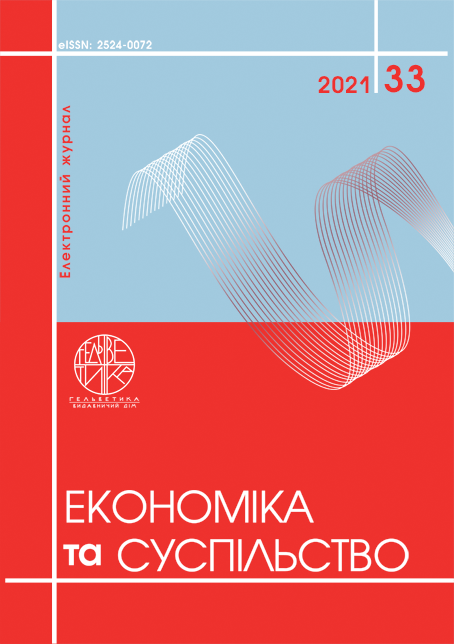ECONOMIC-MATHEMATICAL MODELING APPLICATION FOR THE AGRICULTURE FIELD ANALYSIS
Abstract
The article is devoted to the analysis of existing economic-mathematical models that used for analytics in the field of agriculture and agro-industrial sector (AIC) in general. According to the position of the agro-industrial complex in the structure of the national economy of Ukraine and its importance, there is a need for new researches. The relevance of the research is due to the role of the agricultural sector in GDP and its share in the foreign trade balance. The agricultural sector is one of the key sectors of Ukraine's economy. It is one of the key factors determining Ukraine's position in the world market of goods and services. The agricultural sector provides food to end users (population) and provides raw materials to other sectors of the agro-industrial complex (AIC) and the secondary sector of the economy. In fact, agriculture is the only sector in the structure of Ukraine's national economy, which even in the 2007-2008 crisis years steadily increased its GDP (the share in the country's GDP was up to 13.6%). According to experts, the share of the agricultural sector in GDP in the coming periods will reach 25%. Today, more than 18% of the working population is employed in agricultural production. The agricultural sector is constantly evolving and new jobs are being created at various levels – from local farmers and farms, to agricultural holdings with domestic and foreign investment, whose territory covers entire regions and regions of Ukraine. Thus, the agricultural sector develops and stimulates the economy of Ukraine. The paper considers the theoretical basis, approaches of national and foreign scientists. Mathematical modeling in general is a universal and widely used method of scientific knowledge. But it is a complex and multifaceted tool that requires defining the basic conditions of application and delimitation of the areas of application of certain approaches. The main economic and mathematical models, which used in the analytics, are identified and described. The main aspects of the usage of models are analyzed, the existing advantages and disadvantages are given. The article contains an example of the implementation of one of the simplest problems using the economic-mathematical model.
References
Власов М.П,. Шимко П.Д. Моделирование экономических процессов. Ростов н/Д: Феникс, 2005. 409 с.
Державна служба статистики України. URL: http://www.ukrstat.gov.ua/
Вітлінський В.В. Моделювання економіки : навчальний посібник. Київ : КНЕУ, 2003. 408 с.
Сирота А.А. Методы и алгоритмы анализа данных и их моделирование в MATLAB. Санкт-Петербург : БХВ-Петербург, 2016. 384 с.
Лавров Є.А. Перхун Л.П., Шендрик В.В. Математичні методи дослідження операцій. Суми : Сумський державний університет, 2017. 212 с.
Вітілнський В.В., Великоіваненко Г.І. Кількісне оцінювання ризику у фінансово-економічній сфері. Фінанси України. 2011. №11. С. 16–25.
Пересада А.А. Шевченко О.Г., Коваленко Ю.М. Портфельне інвестування. Київ : КНЕУ, 2004. 408 с.
Vlasov, M.P., & Shymko, P.D. (2005). Modelirovanie ekonomicheskih processov [Modeling of economic processes]. Rostov-on-Don: Feniks. (in Russian)
Derzhavna sluzhba statystyky Ukrainy [State Statistics Service of Ukraine]. Retrieved from http://www.ukrstat.gov.ua/.
Vitlinskyi, V.V. (2003). Modeluvannya ekonomiky: navchalnyy posibnyk [Modeling of the economy: the tutorial]. Kyiv: KNEU. (in Ukrainian)
Sirota, A.A. (2016). Metody i algoritmy analiza dannyh I ih modelirovanie v MATLAB [Methods and algorhytms for data analysis and modeling in Matlab]. Saint-Petersburg: BHV-Peterburg. (in Russian)
Lavrov, E.A., Perhun, L.P. & Shendryk, V.V. (2017). Matematychni metody doslidzhennya operaciy [Mathematical methods of operations research]. Sumy: SDU. (in Ukrainian)
Vitlinskyi, V.V. & Velykoivanenko, H.I. (2011). “Quantitive risk assessment in financial and economic sphere”, Finansy Ukrainy, vol. 11, pp. 16-25. (in Ukrainian)
Peresada, A.A., Shevchenko, O.G. & Kovalenko, U.M. (2004). Portfelne investuvannya [Portfolio investment]. Kyiv: KNEU. (in Ukrainian)


